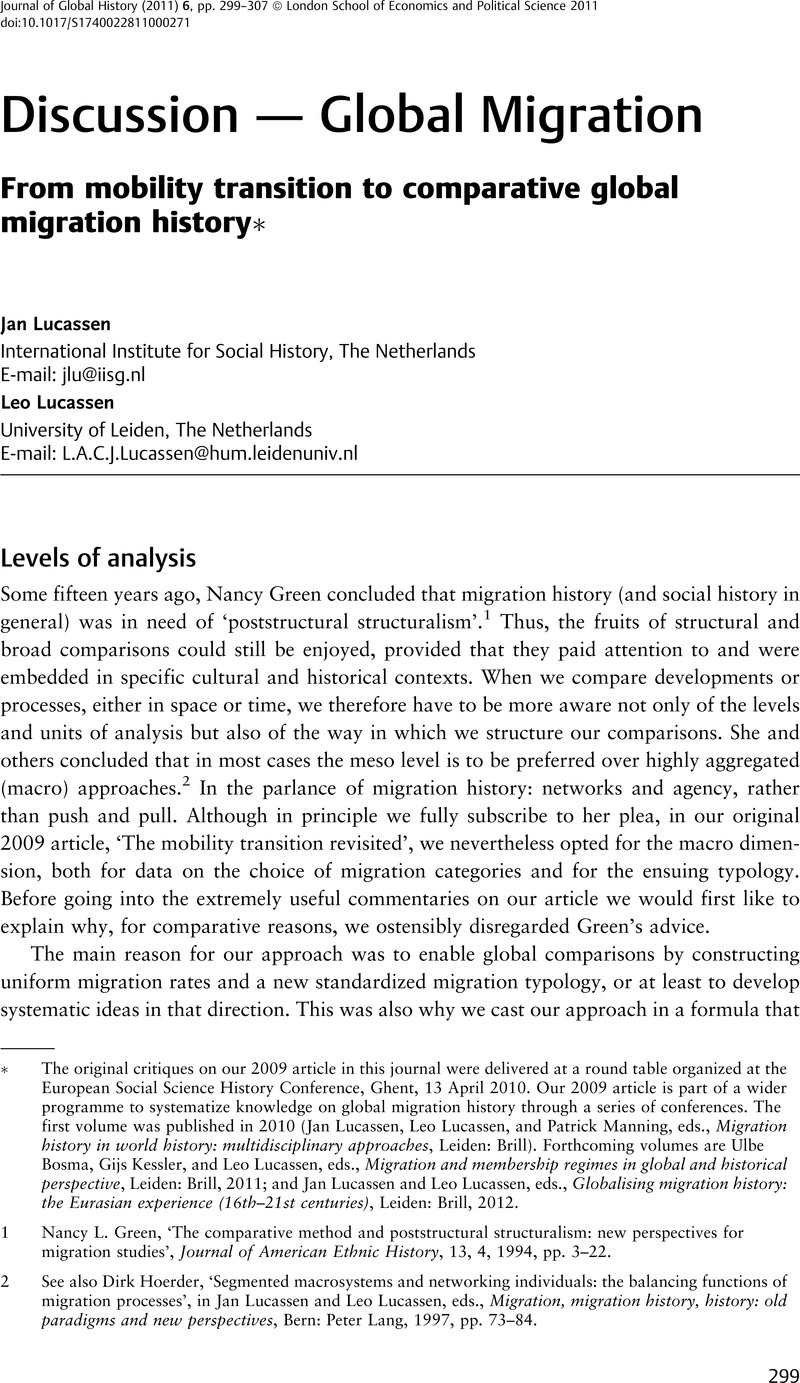Article contents
From mobility transition to comparative global migration history*
Published online by Cambridge University Press: 13 June 2011
Abstract

- Type
- Discussion — Global Migration
- Information
- Copyright
- Copyright © Cambridge University Press 2011
References
1 Nancy L. Green, ‘The comparative method and poststructural structuralism: new perspectives for migration studies’, Journal of American Ethnic History, 13, 4, 1994, pp. 3–22.
2 See also Dirk Hoerder, ‘Segmented macrosystems and networking individuals: the balancing functions of migration processes’, in Lucassen, Jan and Lucassen, Leo, eds., Migration, migration history, history: old paradigms and new perspectives, Bern: Peter Lang, 1997, pp. 73–84Google Scholar.
3 Tilly, Charles, Coercion, capital and European states, AD 990–1992, Oxford: Blackwell, 1990Google Scholar.
4 With the exception of the Dutch Republic and the Ottoman empire: Charles H. Parker, ‘Paying for the privilege: the management of public order and religious pluralism in two early modern societies’, Journal of World History, 17, 2006, pp. 267–96.
5 C. Campbell and J. Z. Lee, ‘Free and unfree labor in Qing China: emigration and escape among the bannermen of north-east China, 1789–1909’, The History of the Family: An International Quarterly, 6, 2001, pp. 455–76; Burds, Jeffrey, Peasant dreams and market politics: labor migration and the Russian village, 1861–1905, Pittsburgh, PA: University of Pittsburgh Press, 1998Google Scholar.
6 For recent contributions to this debate, see Robert C. Allen, Jean Pascal Bassino, Debin Ma, Christine Moll-Murata, and Jan Luiten van Zanden, ‘Wages, prices, and living standards in China, 1738–1925: in comparison with Europe, Japan, and India’, Economic History Review, 64, 2011, pp. 8–38.
7 Sunderland, Willard, Taming the wild field: colonization and empire on the Russian Steppe, Ithaca, NY: Cornell University Press, 2004Google Scholar.
8 Jan Lucassen and Leo Lucassen ‘Transhumanz’, in Friedrich Jaeger, ed., Enzyklopädie der Neuzeit, vol. 13, Stuttgart: J.B. Metzler, forthcoming 2011.
9 Curtin, P. D., Death by migration: Europe’s encounter with the tropical world in the nineteenth century, Cambridge: Cambridge University Press, 1989CrossRefGoogle Scholar.
10 Cressy, David, Coming over: migration and communication between England and New England in the seventeenth century, Cambridge: Cambridge University Press, 1987Google Scholar; Jelle van Lottum, Jan Lucassen, and Lex Heerma van Voss, ‘Sailors, national and international labour markets and national identity’, in Unger, R. W., ed., Shipping and economic growth 1350–1850, Leiden: Brill, 2011, pp. 309–52CrossRefGoogle Scholar; Mattias van Rossum, Lex Heerma van Voss, Jelle van Lottum, and Jan Lucassen, ‘National and international labour markets for sailors in European, Atlantic and Asian waters, 1600–1850’, in M. Fusaro and A. Polónia, eds., Maritime history as global history, St John’s, Newfoundland: International Maritime Economic History Association, 2010, pp. 47–72.
11 O’Rourke, Kevin H. and Williamson, Jeffrey G., Globalization and history: the evolution of a nineteenth-century Atlantic economy, Cambridge MA: MIT Press, 2000Google Scholar.
12 In 1840, the urbanization rate in the Lower Yangtze delta was 11%, much higher than the Chinese average (4%) but considerably lower than in north-west Europe (c.40%): Robert Brenner and Christopher Isett, ‘England’s divergence from China’s Yangzi delta: property relations, microeconomics, and patterns of development’, Journal of Asian Studies, 61, 2002, p. 636; Paolo Malanima, ‘Urbanization’, in Broadberry, Stephen and O’Rourke, Kevin, eds., The Cambridge economic history of modern Europe. Vol 1: 1700–1870, Cambridge: Cambridge University Press, 2010, pp. 235–63CrossRefGoogle Scholar.
13 Jan Lucassen and Leo Lucassen, ‘The mobility transition in Europe revisited, 1500–1900: sources and methods’, International Institute of Social History Research Paper 46, Amsterdam 2010, http://www.iisg.nl/publications/respap46.pdf (consulted 9 April 2011), p. 8.
14 See also Jelle van Lottum, ‘Labour migration and economic performance: London and the Randstad, c. 1600–1800’, Economic History Review, forthcoming, published online August 2010, http://onlinelibrary.wiley.com/doi/10.1111/j.1468-0289.2010.00547.x/pdf (consulted 9 April 2011).
15 van Zanden, Jan Luiten, The long road to the Industrial Revolution: the European economy in a global perspective 1000–1800, Leiden: Brill, 2009Google Scholar; Davids, Karel and Lucassen, Jan, eds., A miracle mirrored: the Dutch Republic in European perspective, Cambridge: Cambridge University Press, 1995Google Scholar.
16 Patrick Manning, ‘Cross-community migration: a distinctive human pattern’, Social Evolution and History, 5, 2006, pp. 24–54.
17 Clark, Peter and Slack, Paul, English towns in transition 1500–1700, London: Oxford University Press, 1976Google Scholar.
18 Dirk Hoerder, ‘From dreams to possibilities: the secularization of hope and the quest for independence’, in Hoerder, D. and Rössler, H., eds., Distant magnets: expectations and realities in the immigrant experience, 1840–1930, New York: Holmes & Meier, 1993, p. 2Google Scholar.
19 Wyman, M., Round-trip America: the immigrants’ return to Europe, 1880–1930, Ithaca, NY: Cornell University Press, 1993Google Scholar.
- 7
- Cited by




